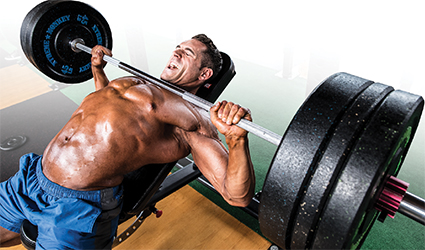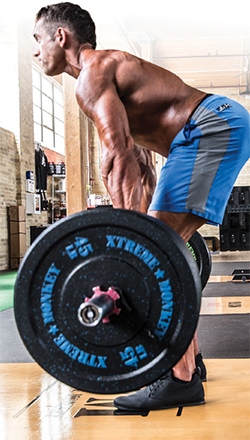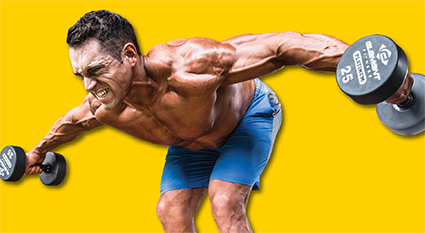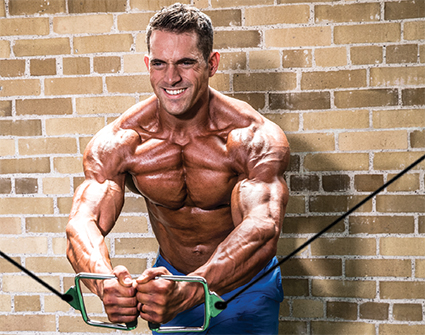The Perfect Workout: 4x4 Training

Build strength, size, definition, and get a crazy pump all in the same workout! That’s the promise of the 4×4 system.
It’s no secret that building muscle takes lots of hard work, long-term commitment and—who would’ve thought—an understanding of math. In fact, basic math skills can be helpful to any bodybuilder looking to progress because they enable you to envision how the geometry of changing exercise angles works a target muscle differently, quickly assess how many grams of protein are in a chicken breast and egg white omelet, and add up how many pounds are under the Olympic bar with six 45-pound wheels on each side. But rather than focus on the merits of studying algebra, let’s instead educate you on how you can apply a simple mathematical principle to boost your training results. But before you decide that your flunking mathematics grades disqualify you from reaping math-based benefits, let’s state from the beginning of class that all you need to do is be able to count to four. As in one, two, three, four.

The 4×4 training system is unique method because it enables you not only to train for strength and muscle size gains but also to increase your muscular endurance and achieve a wicked muscle pump … all in the same workout. That, in fact, is already what many aspiring bodybuilders already do. It’s all done by manipulating the amount of weight you lift.
In a nutshell, in the 4×4 system you do 4 sets of 4 or 5 exercises for a given muscle group (3 exercises for advanced beginners) with each move working the target body part from a slightly different angle. Makes sense. But what makes the protocol unusual is that each exercise provides a unique training stimulus:
- The first move is done very heavy for a set of just 4 reps to focus on building maximal strength;
- The second is done with relatively lighter weights—hitting failure at 8 reps—to focus on muscle size, on the lower end of the optimal hypertrophy range;
- The third is done with even lighter weights that also builds size on the upper end of the optimal hypertrophy zone—12 reps;
- And the last move is done with very light weights taken to 16 reps to pump the muscle by initiating intra-muscular biochemical changes and driving fluids into the muscle cell, and that encourages a degree of muscular endurance.
USING THE RIGHT WEIGHT
In the end, you fortunately won’t need an advanced degree in math. But you will have to grasp the understanding of the inverse relationship between load and reps, which for many of us is pretty obvious. Use a heavier load and you can do fewer reps; lighter weights, you can do for more reps. If you were to plot on a graph all the possible working weights and reps of a given exercise you do, it would form a line, and for our purposes here, you’ll be using as working weights those loads that correspond with your rep target for each exercise. It’s all about the power of fours: 4, 8, 12, 16.
By combining heavy weights for low reps, moderate weights for moderate reps, and light weight for high reps in the same workout, you’re able to work each target muscle group for strength, size and endurance while encouraging the release of muscle-building hormones in a single workout. The end result will be that you’re big, strong, and pumped.
 PUTTING THE WORKOUT TOGETHER
PUTTING THE WORKOUT TOGETHER
Because you’re starting the workout with heavy weights, a good warm-up is essential. Include several lighter sets, pyramiding the weight up each successive set but never taking warm-up sets to muscle failure.
1. Choose a weight on your first exercise in which you can complete just 4 reps and do 3 to 5 sets, depending on your training level. Select basic, mass-building moves early in your workout when your energy levels are high that are multi-joint in nature. Bench press for chest, squat for legs, overhead barbell press for shoulders … that’s the formula. If you can do 6 reps with good form on such multi-joint moves, the weight’s too light, so add more for your next set. After a slightly longer than normal rest period—don’t hurry on your heaviest sets to ensure that you’re fully recovered for your next effort—repeat the lift again. Remember, it’s important here not just to choose the right first exercise, but the right weight as well.
Two points to remember: The longer rest periods will improve recuperation, but cumulative fatigue goes hand in hand with bodybuilding training, so you may have to adjust the weight you use on successive sets to ensure you’re still hitting 4 (or 8, 12, or 16, depending on whether the exercise comes first, second, third, or last in your workout). Second, especially on your heavier sets, get a spotter for safety.
2. On your second move, do 3 to 5 sets of 8 reps. Research shows that you can stimulate maximum muscle growth when you choose a weight that causes muscle failure at about 8 to 12 reps. On the second movement, we’re targeting the lower end of the range. This should be another multi-joint exercise, done from a different angle and with a different piece of equipment. That is, if you started with a flat-bench barbell press for your first chest move, for example, then do incline or decline dumbbell presses next.
Dumbbells force each side to work independently, which requires greater stabilizer involvement and coordination, and often allows for a longer range of motion, meaning the target muscles will be worked in a slightly different manner. And by changing the angle combined with a relatively lighter weight (remember, the target on the second move is 8 reps), you more optimally change up the stimulus on the target body part. In sum, that means: different angle, different kind of equipment, different relative intensity. (Note: It’s not feasible to work a small muscle group such as the biceps with compound moves, so make sure you choose better mass-builders for your first two moves, such as the standing barbell curl and incline-bench dumbbell curl.)
3. Do 3 sets of 12 reps on your third exercise. The relatively lighter weights provide a different kind of stimulus for muscle growth, and it makes sense to go somewhat lighter in your workout as you start to accumulate fatigue. The amount of resistance will still promote muscle growth by encouraging biochemical changes in the muscle, but the stimulus is a bit different here because of the change in what’s called the relative intensity.
If you used a barbell and dumbbells in your first two exercises, now would be a good time to do a machine exercise because you don’t need to worry about balancing a weight: You just get set in position and move the load. You could do either another multi-joint move from a different angle (such as a decline press for chest to complement the incline and flat-bench presses you did in the first two exercises) or possibly even an isolation exercise like a cable crossover or pec-deck flye.
Single-joint moves reduce the contribution from secondary muscle groups (remember, you lock your elbows in a slightly bent arm position during the entire flye motion), which removes the triceps from the equation. While you can’t use very heavy weights with such exercises, it really doesn’t matter at this point because you’re doing them toward the end of your workout, and the very heavy stuff should already be behind you. Just choose a weight with which you can do 12 reps—-no more, no less.

4. Finish with a move done for 3 sets of 16 reps.
These high-rep sets will help pump the muscle, which is important for growth and recovery because the infusion of blood delivers nutrients, oxygen, and anabolic hormones to the muscle, which helps clear the by-products of anaerobic metabolism. The swell in the muscle created by the muscle pump also stretches the muscle cell membrane, which is believed to help trigger the muscle-growth processes.
As the fourth move in your routine, choose an isolation exercise—aka single-joint move—such as the cable crossover or pec deck for chest, leg extension for quads, or straight-arm pull-down for back—to work the target muscle not only from a different angle but also in a different manner. Make sure you go fairly light; select a weight with which you can complete 16 reps for each of 3 to 5 sets. Here, the amount of weight isn’t the issue; rather, it’s what you feel in the muscle: You should be focused on pumping the muscle and feeling it burn. Once you hit that last rep, you’ll know it’s been a sweet 16.
One note: Smaller muscle groups such as shoulders, hamstrings, biceps, and even triceps don’t have as many multi-joint variations to choose from, but do your best to include them whenever possible. That could mean an overhead press and upright row in your delt routine, starting biceps with chin-ups (that’s the one with an underhand grip), using close-grip benches and various types of weighted dips early in your triceps training, and for hamstrings, possibly choosing only two exercises and skipping the very heavy phase.

Building a 4×4 Workout
Below are sample 4×4 workouts for chest and legs. The exercise order can be changed to some degree, but always start with your major mass-builders and finish with single-joint moves. Tilt toward the lower number of sets if you’re a beginner; and add more (volume) the more advanced you are. Typically rest 60 to 90 seconds between sets, though add a minute to that on the first exercise of each workout.
CHEST
Exercise Sets1 Reps2
Incline Barbell Press 3–5 4
Flat-Bench Dumbbell Press 3–5 8
Decline Machine Press 3–5 12
Pec-Deck Machine 3–5 16
LEGS
Exercise Sets1 Reps2
Squat 3–5 4
Leg Press 3–5 8
Weighted Lunge 3–5 12
Leg Extension 3–5 16
Romanian Deadlift 3–5 8
Lying Leg Curl 3–5 12
1. Excludes warm-up sets. Do as many as you need, but never take warm-ups to muscle failure.
2. Select the load such that you reach or near muscle failure by the target rep. Adjust the weight on successive sets as necessary.

Manipulating the 4-Rep System
While the 4×4 workout is typically done by going heavy on all sets of your first move, you can add variety to your training by working the muscle from heavy to light (which is called a reverse-pyramid system) or light to heavy (pyramid), all within the same exercise. For example, with the reverse pyramid the first set of each exercise is done for just 4 reps, the second set of all movements for 8 reps, all third sets are done for 12 reps, and the fourth sets are taken to 16. This requires you to change the weight on each set of every exercise, so it’s a bit cumbersome. It also requires you to be somewhat familiar with what your personal strength-to-reps ratio for each move and the order in which you do it. Using this approach creates a different relative intensity on every set.
One point: When following a pyramid approach, which is considered best for strength training, do not take the early sets to muscle failure until you get to the top weight. Taking lighter-weight sets to failure builds up fatigue that causes you to sacrifice strength on your heavier sets to come. Pyramid-training systems also have the warm-up built in, but do more if you so need. Following a reverse-pyramid system, in which you start with the heaviest loads, allows you to take more total sets to failure and is thus considered slightly superior for bodybuilding purposes.
Remember, too, very heavy loads are never recommended for single-joint exercises because of the amount of weight that has to be absorbed by the joint. With those, ditch the very heaviest set.
Of course, you could conceivably build a workout that includes exercises that alternate pyramid and reverse-pyramid elements. That’s a great way to break up your training when you want a different training stimulus.
Here are sample workouts for shoulders and triceps.
SHOULDERS (Reverse Pyramid)
Exercise Sets1 Reps2
Seated Overhead Barbell Press 4 4, 8, 12, 16
Upright Row 4 4, 8, 12, 16
Bent-Over Lateral Raise 3 8, 12, 16
Front Raise 3 8, 12, 16
Dumbbell Lateral Raise 3 8, 12, 16
TRICEPS (Pyramid)
Exercise Sets3 Reps4
Triceps Dip Machine 4 16, 12, 8, 4
Close-Grip Bench Press 4 16, 12, 8, 4
Press-down 3 16, 12, 8
1. Excludes warm-up sets. Do as many as you need, but never take warm-ups to muscle failure.
2. Select the load such that you reach or near muscle failure by the target rep. Adjust the weight on successive sets as necessary.
3. Warm-up sets are built into pyramid schemes, but add extra sets if necessary.
4. For a better strength focus, take only your last (heaviest) set to muscle failure.
Get articles delivered to you each month by signing up to the FREE Muscle Insider newsletter. Just click here.


